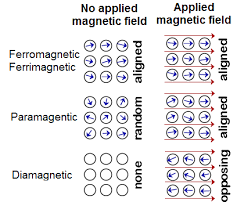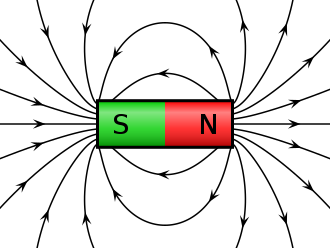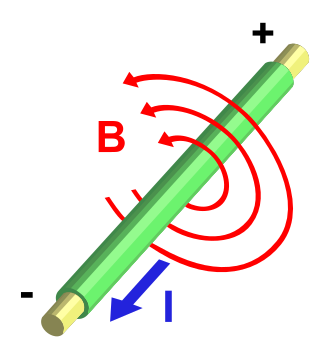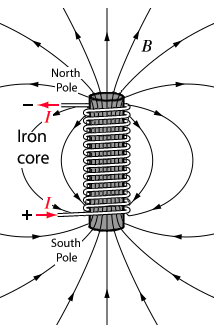The difference between the permanent magnet and electromagnet is in their strengths and fields. The magnetic field of a permanent magnet is always constant, but the electromagnetic magnetic field is created by establishing an electric current and ends by removing the current.
The difference in strength between the two is due to the type of magnetization. That is, if the magnetic property of the permanent magnet is greater, the magnet is stronger. But in the case of the electromagnet, the strength depends on the electric current.
In this article, both types of magnets are introduced and then any difference between the permanent magnet and electromagnet is discussed.
Magnet
Any object that creates a magnetic field is called a magnet. The magnetic field is not visible, but it has an absorbing effect on ferromagnetic materials such as iron, nickel, cobalt, etc. It also has an absorption or repulsion effect on other magnets.
Magnetism
Magnets generally refer to objects that generate a stable magnetic field, even if no magnetic field is applied to them. This is a characteristic of a particular category of materials. Of course, most materials produce a magnetic field when a magnetic field is applied to them. This phenomenon is called magnetism, which has different types. Each substance exhibits at least one type of magnetism.
What kind of magnetic behavior a substance exhibit depends on its overall structure and in particular the arrangement of its electrons. The most known types of the magnetic behavior of different materials are as follows:
Ferromagnetic and Ferrimagnetic
Ferromagnetic and ferrimagnetic materials are those which are attracted to a magnet and, of course, can become a magnet while maintaining their magnetization. Ferromagnetic and ferromagnetic materials are similar, but ferromagnetic materials are stronger than other ones. The difference is in their internal structure.
Paramagnetic
Paramagnetic materials are substances that are very poorly absorbed by magnets, such as oxygen, platinum, and aluminum. These materials cannot be magnetized. The absorption of these materials into magnets is thousands of times weaker than that of ferromagnetic materials.
Diamagnetic
Diamagnetic means repulsion by a magnet. These materials do not have magnetic properties. Examples of these materials are plastics, water, carbon, and copper. Most materials fall into this category. Superconducting materials are also in this category because they completely repel the magnetic field.
The figure below shows the magnetic behavior of different materials with and without the presence of a magnetic field.

Permanent Magnet
Any object that is made from a magnetized material and can generate a permanent magnetic field is a permanent magnet. The materials that are well attracted to the magnet are ferromagnetic materials as well as ferrimagnetic materials. Nickel, iron, cobalt, and their alloys are among these materials.
The use of permanent magnets is widespread in our daily lives. Like a refrigerator magnet. Of course, many of the daily applications of permanent magnets are not visible, but without them, many of our daily routines are impossible. Such as the role of magnets in the operation of cars, imaging systems, generators, televisions, personal computers, telephones, and so on.
Hard materials that are highly magnetized become permanent magnets. An example that fully describes the behavior of a permanent magnet is the bar magnet. Permanent magnets are often referred to as bar magnets.
Magnets are either natural or artificial. Natural magnets like lodestones naturally have a weak magnetic field. But artificial magnets are handmade, have a stronger field, and are made in any way that is suitable for human use.
The magnet has two poles: the north pole and the south Pole. When we suspend a magnet, the north is the pole that lies in the direction of the earth’s north magnetic pole, and vice versa to determine the south pole of the magnet. If you break a bar magnet in the middle, it will still have two poles, north and south. No matter how many times you continue this break, the two poles, the north and south poles remain for it.
The strongest magnetic property is a magnet at its poles. When you place two bar magnets next to each other, poles of the same name repel each other, and poles of the same name attract each other. A bar magnet also absorbs all ferromagnetic materials.

How Is a Permanent Magnet Created?
Permanent magnetism is created by the internal structure of a substance. Inside the atoms are the electrons and nuclei of the atoms, which themselves are inherently magnetic and spin like pieces of electric charge. Also, by rotating the electron around the nucleus on the electron circuits, a magnetic field is created.
So the magnetic field of permanent magnets is the result of three factors in the microscopic view: electron spins, nucleus spins, and electron orbits.
Many materials do not have permanent magnetic properties, because the magnetic fields of each of these factors randomly point in all directions and neutralize each other. But in ferromagnetic materials, the fields caused by the rotation of the nucleus and the electron and the electron circuit are added together, amplifying each other and creating a permanent magnetic field.
The strength of a permanent magnet depends entirely on the internal structure of the material. The strongest permanent magnetic field has a power of 8,000 Gauss. Of course, up to 450,000 Gauss has been obtained in the laboratory.
Magnetic Field Lines
If we place the magnet on a piece of paper and sprinkle the iron filings around them, the position that the iron filings form around the magnet of the magnet represents the magnetic field lines. In fact, magnetic field lines are a set of hypothetical lines that show the strength and orientation of the field around the magnetic material.
Magnetic field lines have the following characteristics:
- These lines are closed and continuous.
- The tangent line at any point represents the direction of the magnetic field at that point.
- Dense lines represent a field with more strength.
- The lines of the magnetic field do not intersect.

Permanent Magnet Types
Types of permanent magnets include the following:
Ceramic Magnet
Ceramic magnets are the cheapest permanent magnets used in cases like food processing.
Flexible Magnet
These magnets can be made from a combination of polymers, plastics, and magnetic powders. An example is the use of flexible magnets in refrigerator doors.
Neodymium Iron Boron Magnet
These types of magnets (NdFeB) are used in making jewelry. They are rare, expensive, and a kind of earthen magnet.
Samarium Cobalt Magnet
This is also a kind of earthen magnet. So, it is rare and expensive but resistant to oxidation, unlike the NdFeB magnet. The use of this magnet (SmCo) is in turbomachinery.
Properties of Permanent Magnets
- A permanent magnet creates a strong magnetic field even if its mass is low.
- A good permanent magnet is resistant to demagnetization.
- The application of a permanent magnet is at a certain temperature. Therefore, they do not work appropriately in devices that operate at high temperatures.
- The resistance of a permanent magnet to corrosion is low over time; therefore, its strength gradually decreases.
- The poles of a permanent magnet cannot be changed.
Electromagnet
An electromagnetic field is generated by an electric current inside a wire wound into a coil around a core made of a ferromagnetic material such as iron. A magnetic field is created towards the center of the coil and the metal core increases its strength. By removing the electric current, the magnetic field also disappears.
In the following figure, you see the direction of a magnetic field (B) created by an electric current (I).

The formula to calculate the magnetic field created by a current is as below:
B=\frac{{\mu_{0}}I}{2{\pi}r}
{\mu_{0}}=4{\pi}\times 10^{-7}\frac{Tm}{A}
Tesla (T) is the unit of magnetic flux density (B) per unit cross-sectional area. Also, r is the radial distance from the current wire.
The application of electromagnets in the electrical industry and mechanical equipment is very wide. For example, they are used in engines, generators, hard disks, speakers, and cranes to lift heavy objects, as well as medical equipment such as MRI.
Electromagnets are used in Transformers in which the coils generate changing magnetic fields with supply the electric current to induce the voltage. The most used transformers in the power system are to control the alternative voltages.
According to Ampere’s law, the electric current inside a wire creates a magnetic field around the wire. If a number of wires are wound beside each other, a strong centralized field is created in their center. A coil that makes a straight tube is called a solenoid.
Ampere’s law states that the integral of magnetic field intensity (H) inside a closed loop is equal to the sum of the current summation passing through the loop. In mathematical language it means:
\oint H.dL=\int J.dA
To the right of the above equation can be written as the algebraic sum of the currents passing through the loop.
\oint H.dL=I_{enc}
If we want to calculate the magnetic field in a ring with radius r, the above relation can be written as follows:
2{\pi}rH=I_{enc}
Or
H=\frac{I_{enc}}{2{\pi}r}
The direction of the magnetic field can be found with the help of the right-hand rule. In this way, if the fingers of the right hand are bent in the direction of the current inside the coils, the thumb of the right hand will be in the direction of the magnetic field. The direction from which the field lines extend represents the North Pole.
The relation between B and H is as the following relation.
H=\frac{B}{{\mu}}-M
Here, M and μ are magnetizations and magnetic permeability, respectively.
It is necessary to mention Maxwell’s equation which explains the relationship between an electric field and a magnetic field.
{\nabla}\times \overrightarrow{E}=-\frac{{\partial}\overrightarrow{B}}{{\partial}t}
The magnetic flux density and electric field strength exert the force on a charge q moving with the velocity of v which is explained by the Lorentz force equation.
\overrightarrow{F}=q(\overrightarrow{E}+\overrightarrow{v}\times \overrightarrow{B})
Applying Stokes’s theorem to Maxwell’s equation leads to the following equation.
\oint E.dL=-\frac{{\partial}}{{\partial}t}\int \overrightarrow{B}.d\overrightarrow{A}
Integration of the electric field around a closed loop leads to defining the electromotive force ζ. Also, Φ denotes the magnetic flux, the integral on the surface surrounded by the loop of the magnetic flux density.
{\zeta}=-\frac{\partial{\Phi}}{\partial{t}}
This is called Faraday’s law of electromagnetic induction which says if a conductor is located across a changing magnetic field, induction of electromotive force happens.
Magnetic Core
If a core made of ferromagnetic material is used in the center of the coil, the magnetic field can be amplified up to thousands of times due to the high permeability coefficient of the material. These types of electromagnets are called ferromagnetic cores or iron cores.
Of course, not all electromagnets are of ferromagnetic core types, especially very strong electromagnets such as superconductors or those with very high currents inside their coils are not able to have a core.
The material used in the electromagnetic core has small regions called magnetic domains. Normally, they are oriented in such a way that they neutralize the magnetic effect of each other and the object is not considered a magnet. But as soon as a current is created in the coil around the object, the resulting magnetic field directs small magnetic regions and parallels them.
So the effect of the coil current field and the magnetic field reinforce each other in the same direction. This creates a very strong magnetic field.
The higher the current inside the coil, the stronger the magnetic field is created. However, this procedure does not exist unlimitedly, and since all magnetic fields are oriented, then increasing the current intensity of the circuit very little causes the field to strengthen. This state is called saturation.
When the electric current is removed, the magnetic domains inside the core lose their alignment and return to their previous random arrangement. But some alignments remain, and the core remains a weak magnet. This state is called hysteresis. Also, the residual magnetic field is called remnant magnetism.
The following figure shows the magnetic field lines around an iron core electromagnet.

Properties of Electromagnet
- The electromagnetic magnetic field, like a permanent magnet, has imaginary field lines.
- Electromagnets have both north and south poles, like permanent magnets.
- Electromagnets cost less than permanent magnets.
- The electromagnet power can be adjusted according to your needs.
- The maintenance required for electromagnets is high.
- They are not suitable for small spaces, because they require a lot of copper couplings.
- There are some side effects that should be considered in the design of electromagnets, such as ohmic heat, inductive voltage spikes, Lorentz forces, and core losses.
In this video, you can learn more about electromagnetism or electromagnetic force.
Difference between Permanent Magnet and Electromagnet
After a complete introduction and discussion of the features of each, we will describe the difference between the permanent magnet and electromagnets. These differences are mentioned in the following cases.
The Difference in Magnetization types
The main difference between permanent magnets and electromagnets is the ways they are magnetized. The permanent magnet is permanently magnetized, but the electromagnet is temporarily magnetized.
The Difference in Materials
Another difference between permanent magnets and the electromagnet is their materials. Permanent magnets are usually made of hard materials, but the material used in the electromagnet is soft.
The Difference in Poles’ Positioning
The position of poles is a difference between a permanent magnet and an electromagnet. In a permanent magnet, the poles are fixed and do not change. But in the electromagnet, the poles can change.
The Difference in Strengths
There is a difference between the permanent magnets and electromagnets in the strengths. The strength of the magnetic field in a permanent magnet is constant, but the strength of the electromagnetic magnetic field is proportional to the user’s needs.
Buy Equipment or Ask for a Service
By using Linquip RFQ Service, you can expect to receive quotations from various suppliers across multiple industries and regions.
Click Here to Request a Quotation From Suppliers and Service Providers
Read More on Linquip
- Difference Between FDM and TDM: Basic Points
- 3 Types of Magnets + Name & Applications
- Difference between Electric and Magnetic Fields
- Difference Between Mechanical and Electromagnetic Waves
- Superconducting Magnetic Energy Storage
- The Beginner’s Guide To Permanent Magnet Synchronous Motors
- Difference between Electromagnetic Waves and Matter Waves



